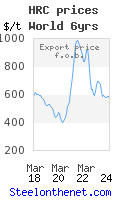The steel sector in Vietnam
When compared to its larger Asian neighbours, Vietnam China Vietnam is also an important market for Chinese producers, being the second largest behind South Korea
With a steady increase of over 6% in the country’s GDP forecast for this year, a similarly favourable outlook for the construction industry and an automotive market that was the second fastest growth market globally last year, it would seem that Vietnam
This may not actually be the case, however. Traditionally Vietnam Formosa
So far this year, Vietnam
It would seem then, that the measures put in place to boost the domestic steel industry are working, and at the detriment of imports from overseas suppliers. So far, given the strength of the steel market in China
The text above was prepared by ISSB.
You can download a file showing exporters to Vietnam
Labels: Formosa Steel, Hoa Phat, ISSB, steel market in Vietnam, Vietnam steel industry, Vietnam steel trade



